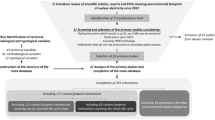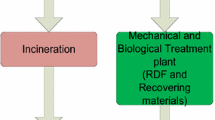Abstract
Purpose
Environmental impacts of the decommissioning of nuclear power plants are brought into focus by the nuclear phase-out in Germany and a worldwide growing number of decommissioning projects. So far, life cycle assessments of decommissioning nuclear power plants have been conducted very rarely or are based on rather uncertain assumptions. Against this background, environmental impacts of the ongoing decommissioning of the nuclear power plant in Lubmin (KGR), Germany are examined. Methodological aspects like transferability to other decommissioning projects as well as influence of assumptions about the lifespan of a power plant are discussed.
Methods
A life cycle assessment of the decommissioning according to ISO 14040/44 is conducted. The decommissioning of one power plant (of the assessed KGR) is chosen as functional unit. The system boundaries include removal and demolition of plant components and buildings as well as decontamination, conditioning, interim storage, and final repository of low-level and interim-level nuclear waste together with disposal and recycling of conventional waste. Interim storage and final repository of high-level nuclear waste such as fuel rods are excluded from the system boundaries as they are assigned to the use phase of the plant. Primary data was obtained from the plant decommissioning firm (Energiewerke Nord GmbH, EWN) in Lubmin. The GaBi database was used to model background processes. Environmental impacts are estimated using the CML2001 methodology.
Results and discussion
Environmental impacts are mainly caused by on-site energetic demands of component removal and peripheral tasks. Further significant impacts are caused by the handling, storage, and final repository of low-level and intermediate-level nuclear waste. Recycling conventional, nonradioactive metallic waste has the potential to unburden the process in a significant scale, depending on recycling rates.
Conclusions
The dismantling of nuclear power plants shows a relevant environmental impact. Regarding the environmental impacts per kilowatt-hour assumptions concerning the plant’ lifespan are a crucial factor. Comparing the result from this study to recent datasets for nuclear power poses the question if LCA datasets represent environmental burdens of nuclear power accurately.
The transferability of LCA results to other studies using one parameter for scaling is problematic and needs further research.







Similar content being viewed by others
References
Beerten J, Laes E, Meskens G, D’haeseleer W (2009) Greenhouse gas emissions in the nuclear life cycle: a balanced appraisal. Energ Policy 37(12):5056–5068
BfS (2012a) Personal email communication with Achim Thömmes, Fachbereich Sicherheit nuklearer Entsorgung, Arbeitsgruppe übergreifende Aufgaben (18.12.2012) (in German)
BfS (2012b) Konrad – Deutschlands erstes nach Atomgesetz genehmigtes Endlager für schwach- und mittelradioaktive Abfälle. http://www.bfs.de/de/bfs/publikationen/broschueren/endlager/konrad_leporello.pdf (23.05.2014) (in German)
BfS (2013a) Auflistung kerntechnischer Anlagen in der Bundesrepublik Deutschland: Anlagen „In Betrieb“. http://www.bfs.de/de/kerntechnik/Kernanlagen_Betrieb_Nov_2013.pdf (22.02.2014) (in German)
BfS (2013b) Auflistung kerntechnischer Anlagen in der Bundesrepublik Deutschland: Anlagen “In Stilllegung”. http://www.bfs.de/de/kerntechnik/Kernanlagen_Stilllegung_Nov_2013.pdf (22.02.2014) (in German)
BfS (2013c) Personal email communication with Achim Thömmes, Fachbereich Sicherheit nuklearer Entsorgung, Arbeitsgruppe übergreifende Aufgaben (22.02.2014) (in German)
Borlein M (2009) Kerntechnik: Grundlagen. Vogel Fachbuch, Würzburg (in German)
Bundesgesetzblatt (2011) Dreizehntes Gesetz zur Änderung des Atomgesetzes. Bundesanzeiger Verlag, Köln
BMUB (2012a) Endlager für radioaktive Abfälle Morsleben (ERAM). http://www.bmub.bund.de/themen/atomenergie-strahlenschutz/endlagerprojekte/endlager-morsleben/ (23.05.2014) (in German)
BMUB (2012b) Sicherheitsanforderungen an die Endlagerung wärmeentwickelnder radioaktiver Abfälle. http://www.bmub.bund.de/themen/atomenergie-strahlenschutz/nukleare-sicherheit/sicherheit-endlager/sicherheitsanforderungen (23.05.2014) (in German)
DIN (2009a) DIN EN ISO 14040:2006: Umweltmanagement - Ökobilanz - Grundsätze und Rahmenbedingungen. Deutsches Institut für Normung e.V. (in German)
DIN (2009b) DIN EN ISO 14044:2006: Umweltmanagement - Ökobilanz - Anforderungen und Anleitungen. Deutsches Institut für Normung e.V. (in German)
Dones R, Bauer C, Doka G (2009) Kernenergie – ecoinvent report No. 6-VII. Villingen: Ecoinvent Centre - Swiss Centre for Life Cycle Inventories (in German)
Rohde M (2008) Operational experience of Radwaste Management Centre in Lubmin/Germany. http://www.iaea.org/OurWork/ST/NE/NEFW/CEG/documents/ws032008/5.1%20WP1%20Mathias%20eng.pdf (17.05.2014)
EWN (2011) Die Standorte. http://www.ewn-gmbh.de/ewngruppe/ewn/standort-greifswald0/daten-und-fakten/die-abfallmengen.html?L=1index.php (17.01.2014) (in German)
EWN (2012) Die Abfallmengen. http://www.ewn-gmbh.de/ewngruppe/ewn/standort-greifswald0/daten-und-fakten/die-standorte.html?L=1%2F (17.05.2014) (in German)
EWN (2013a) Technical reports from 1995–2010 and energy reports from 2009–2010 (in German)
EWN (2013b) Phone communication with Marlies Philipp, Department for Public Relations (07.02.2013)
EWN (2013c) Mail communication with Carola Schilke, Department P1GS (21.01.2013)
Fthenakis V, Kim H (2011) Photovoltaics: life-cycle analyses. Sol Energy 85(8):1609–1628
Gagnon L, Bélanger C, Uchiyama Y (2002) Life-cycle assessment of electricity generation options: the status of research in year 2001. Energ Policy 30(14):1267–1278
GNS (n.d.) Endlagerprojekte. http://www.endlagerung.de/language=de/7050/historie (31.05.2014) (in German)
Guinée JB, Lindeijer E (2002) Handbook on life cycle assessment: operational guide to the ISO standards. Kluwer Academic Publishers, Dordrecht
Grimes S, Donaldson J, Gomez GC (2008) Report on the Environmental Benefits of Recycling. Bureau of International Recycling, Brüssel
Hennings W (2006) Ökobilanzen für den Sektor Strom und Gas (in German)
Hoffmeyer M, Köhler D, Schwaiger K, Fleißner T (1996) Ganzheitliche energetische Bilanzierung der Energiebereitstellung (GaBiE): Teil II - Energetische Untersuchung eines Kernkraftwerks. Forschungsstelle für Energiewirtschaft, München (in German)
Lenzen M (2008) Life cycle energy and greenhouse gas emissions of nuclear energy: a review. Energy Convers Manag 49(8):2178–2199
Lünser H (1999) Ökobilanzen im Brückenbau: eine umweltbezogene, ganzheitliche Bewertung. Birkhäuser, Basel (in German)
Marheineke T, Krewitt W, Neubarth J, Friedrich R, Voß A (2000) Ganzheitliche Bilanzierung der Energie- und Stoffströme von Energieversorgungstechniken. Institut für Energiewirtschaft und Rationelle Energieanwendung (in German)
Motzko C, Löhr M (2010) Bewertungsmatrix und Abbruchkosten: Bauliche Anlagen KKW Greifswald und Rheinsberg. Report to EWN GmbH (in German)
Nugent D, Sovacool BK (2013) Assessing the lifecycle greenhouse gas emissions from solar PV and wind energy: A critical meta-survey. Energ Policy
Odeh NA, Cockerill TT (2008a) Life cycle analysis of UK coal fired power plants. Energy Convers Manag 49(2):212–220
Odeh NA, Cockerill TT (2008b) Life cycle GHG assessment of fossil fuel power plants with carbon capture and storage. Energ Policy 36(1):367–380
PE (2013) GaBi 5: Software-System and Databases for Life Cycle Engineering. Echterdingen, Stuttgart
Pehnt M, Henkel J (2009) Life cycle assessment of carbon dioxide capture and storage from lignite power plants. Int J Greenh Gas Con 3(1):49–66
Pfeiffer F, McStocker B, Gründler D, Ewig F, Thomauske B, Havenith A, Kettler J (2011) Abfallspezifikation und Mengengerüst, Köln: Gesellschaft für Anlagen- und Reaktorsicherheit (GRS) mbH
Sovacool BK (2008) Valuing the greenhouse gas emissions from nuclear power: a critical survey. Energ Policy 36(8):2950–2963
SCLCI (2013) Swiss Centre for Life Cycle Inventories. Ecoinvent Database v2.2
Sterner H, Leushacke D, Rittscher D (1995) Stilllegung und Abbau des Kernkraftwerks Greifswald. Atw 40(4):247–251
UBA (2013) Prozessorientierte Basisdaten für Umweltmanagement-Instrumente. http://www.probas.umweltbundesamt.de/php/index.php (17.01.2014) (in German)
Wallbridge S, Banford A, Azapagic A (2012) Life cycle environmental impacts of decommissioning Magnox nuclear power plants in the UK. Int J Life Cycle Assess 18(5):990–1008
Zimmermann T, Gößling-Reisemann S (2013) Influence of site specific parameters on environmental performance of wind energy converters. Energy Procedia 20:402–413. doi:10.1016/j.egypro.2012.03.039>
Zimmermann T (2013) Parameterized tool for site specific LCAs of wind energy converters. Int J Life Cycle Assess 18(1):49–60. doi:10.1007/s11367-012-0467-y
Acknowledgments
This study is essentially based on data of Energiewerke Nord GmbH (EWN). We thank Marlies Philips for support during the initiation of this study and Volker Uhde and Günter Hillebrecht for their commitment through data support and expertise. Thanks also go to Achim Thömmes from German Federal Office for Radiation Protection who provided energy consumption data for the construction phase of final repository Konrad.
Author information
Authors and Affiliations
Corresponding author
Additional information
Responsible editor: Adisa Azapagic
Rights and permissions
About this article
Cite this article
Seier, M., Zimmermann, T. Environmental impacts of decommissioning nuclear power plants: methodical challenges, case study, and implications. Int J Life Cycle Assess 19, 1919–1932 (2014). https://doi.org/10.1007/s11367-014-0794-2
Received:
Accepted:
Published:
Issue Date:
DOI: https://doi.org/10.1007/s11367-014-0794-2




